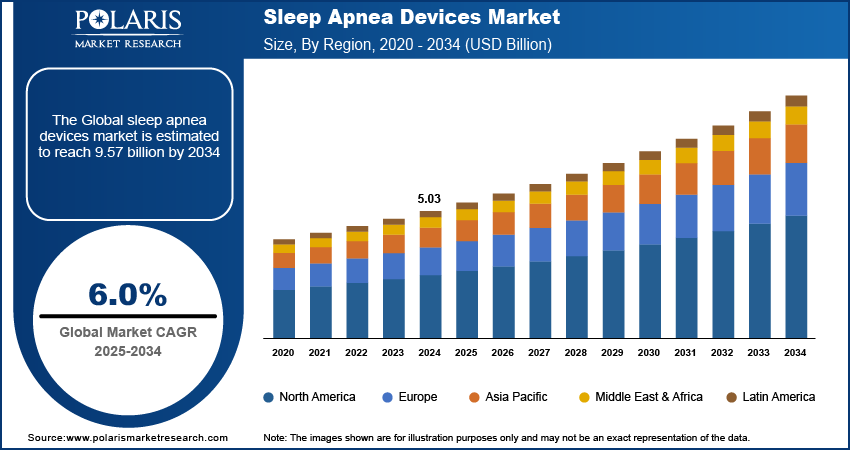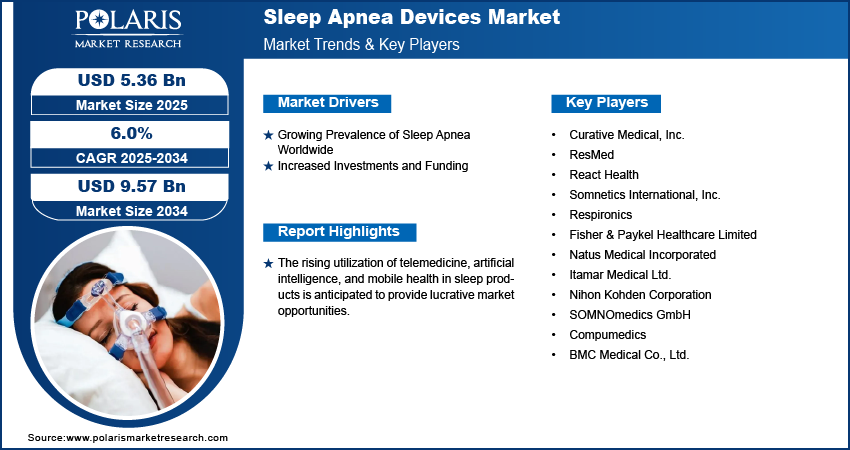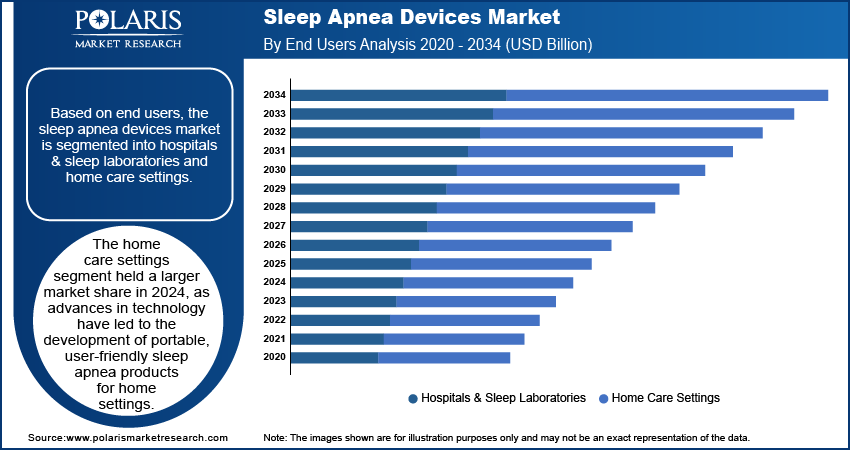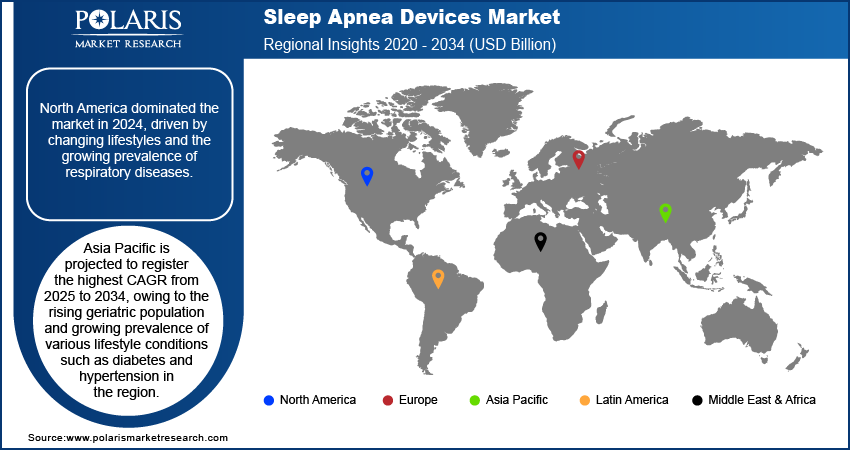
Sleep Apnea Devices Market Size, Share, Trends, Industry Analysis Report: By Devices (Diagnostic Devices and Therapeutic Devices), End Users, and Region (North America, Europe, Asia Pacific, Latin America, and Middle East & Africa) – Market Forecast, 2025–2034
- Published Date:Jan-2025
- Pages: 119
- Format: PDF
- Report ID: PM1597
- Base Year: 2024
- Historical Data: 2020-2023
Sleep Apnea Devices Market Overview
The global sleep apnea devices market was valued at USD 5.03 billion in 2024. The market is projected to grow from USD 5.36 billion in 2025 to USD 9.57 billion by 2034. It is projected to exhibit a CAGR of 6.0% from 2025 to 2034.
Sleep apnea is considered a critical sleeping ailment in which a person’s breathing frequently stops and starts. Obstructive sleep apnea, central sleep apnea, and complex sleep apnea syndrome are three major types of sleep apnea. Obstructive sleep apnea is the most common type and occurs when throat muscles relax, resulting in the upper airway getting repetitively blocked and reducing or completely stopping the airflow. Central sleep apnea, on the other hand, occurs when muscles that control breathing don’t receive appropriate signals from the brain. Complex sleep apnea syndrome, also known as treatment-emergent central sleep apnea, is a condition in which a person suffers from both central sleep apnea and obstructive sleep apnea.

To Understand More About this Research: Request a Free Sample Report
The rising awareness about sleep apnea and increasing technological advancements facilitating effective diagnosis and treatment are among the key factors driving the sleep apnea devices market growth. The growing use of oral appliances for sleep apnea treatment also contributes to the market expansion. Further, increased investments and funding for the development of portable and home-based sleep apnea devices further drive their adoption.
The growing number of people suffering from sleep apnea is one of the major sleep apnea devices market trends expected to drive the demand for sleep apnea devices. According to a World Health Organization (WHO) report, ∽100 million people are affected by sleep apnea worldwide. The National Institute of Health (NIH) estimates that 1 out of 15 adults in the US have mild to severe OSA (obstructive sleep apnea), whereas 1 out of 5 individuals have mild OSA. Additionally, around 42 million people are affected by sleep-disordered breathing (SDB) in the US. These numbers are likely to increase in the coming decade, which is anticipated to increase the demand for treatment/diagnostic devices in the future.
The rising utilization of telemedicine, artificial intelligence, and mobile health in sleep products is anticipated to provide lucrative growth opportunities for market participants during the forecast period.
Sleep Apnea Devices Market Dynamics
Growing Prevalence of Sleep Apnea Worldwide
Sleep apnea is strongly associated with certain factors and conditions, including obesity, elevated stress, a sedentary lifestyle, and poor sleeping patterns. Rising emphasis on maintaining a healthy lifestyle and growing healthcare expenditure are contributing to the growing diagnosis rate of sleep apnea, thereby propelling the demand for sleep apnea devices. Furthermore, the growing number of sleep clinics and technicians is having a favorable impact on the adoption of sleep apnea devices. Therefore, the growing prevalence of sleep apnea among individuals worldwide is one of the major factors driving the sleep apnea devices market development.
Increased Investments and Funding
Leading medical device manufacturers are making significant investments to drive innovations in sleep products. This has led to the development of more efficient, comfortable, and user-friendly sleep apnea devices, contributing to improved patient compliance and therapeutic outcomes. Thus, increased investments and funding for creating advanced sleep apnea devices is a major contributor to the sleep apnea devices market revenue.

Sleep Apnea Devices Market Segment Insights
Sleep Apnea Devices Market Outlook Based on Devices
The sleep apnea devices market, based on devices, is bifurcated into diagnostic devices and therapeutic devices. In 2024, the therapeutic devices segment led the market with an 82.0% revenue share. This category includes positive airway pressure (PAP) devices, oxygen devices, oral appliances, and adaptive servo ventilation (ASV) devices. The devices help treat or prevent apnea by enhancing sleep quality, reducing snoring, and boosting overall mood. Market players focus on innovations in therapeutic devices to improve efficiency and deliver optimal patient outcomes. Further, the rising patient compliance rate, supported by favorable insurance coverage, drives their widespread adoption of therapeutic sleep apnea devices.
Sleep Apnea Devices Market Evaluation Based on End Users
The sleep apnea devices market, based on end users, is segmented into hospitals & sleep laboratories and home care settings. In 2024, the home care settings segment held a larger market share of 62%. Advances in technology have led to the development of portable, user-friendly sleep apnea products for home settings. Compact positive airway pressure (PAP) devices and adaptive servoventilation (ASV) machines enable individuals to manage their sleep apnea at home comfortably. This rising preference for homecare, fueled by its improved convenience and comfort, boosts the growth of the segment.

Sleep Apnea Devices Market Regional Analysis
The market report offers sleep apnea devices market insights into North America, Europe, Asia Pacific, Latin America, and the Middle East & Africa. North America dominated the market with a share of 50.2% in 2024. Changing lifestyles, the growing prevalence of respiratory diseases, and the implementation of favorable government initiatives are a few key factors driving the regional market size. The presence of leading market participants having a strong supply and distribution network further contributes to the regional market expansion.
The Asia Pacific sleep apnea devices market is projected to register the highest CAGR of 6.8% from 2025 to 2034. The rising geriatric population and growing prevalence of various lifestyle conditions such as diabetes and hypertension have led to increased incidence of sleep apnea, thereby driving the adoption of sleep apnea devices in Asia Pacific. Further, increased funding from government and private organizations for easy and early diagnosis of sleep apnea is a key trend estimated to boost the market growth in Asia Pacific.

Sleep Apnea Devices Market – Key Players and Competitive Insights
The leading sleep apnea devices market players are focusing on research and development to improve their product offerings. In addition, they are entering new markets in developing regions to expand their customer base, strengthen their market presence, and increase their share. To expand and survive in a more competitive environment, the key players must offer user-friendly, portable solutions.
In recent years, the market for sleep apnea devices has witnessed several technological and innovation breakthroughs. The research report offers vendor assessment for all the major market participants, including Curative Medical, Inc.; ResMed; React Health (Respiratory Product Line from Invacare Corporation); Somnetics International, Inc.; Respironics (a subsidiary of Koninklijke Philips N.V.); Fisher &; Paykel Healthcare Limited; Natus Medical Incorporated; Itamar Medical Ltd.; Nihon Kohden Corporation; SOMNOmedics GmbH; Compumedics; and BMC Medical Co., Ltd.
List of Key Companies in Sleep Apnea Devices Market
- Curative Medical, Inc.
- ResMed
- React Health (Respiratory Product Line from Invacare Corporation)
- Somnetics International, Inc.
- Respironics (a subsidiary of Koninklijke Philips N.V.)
- Fisher & Paykel Healthcare Limited
- Natus Medical Incorporated
- Itamar Medical Ltd.
- Nihon Kohden Corporation
- SOMNOmedics GmbH
- Compumedics
- BMC Medical Co., Ltd.
Sleep Apnea Devices Industry Developments
June 2024: ResMed announced the launch of its full face mask, AirFit F40. ResMed stated that AirFit F40 comes with an ultra-compact design and is the company’s smallest tube-down full-face mask.
April 2024: Fisher & Paykel Healthcare Limited introduced the F&P SoloTM Nasal mask in the US market. According to the company, the mask is aimed at individuals with obstructive sleep apnea and enables seamless adjusting with just one touch.
May 2024: Novaresp Technologies raised USD 3 million in order to support the clinical trials of its cMAP Positive Airway Pressure software.
February 2024: the FDA approved EnsoData’s Ensosleep, an AI algorithm-based tool used in the diagnosis of sleep disorders like sleep apnea.
Sleep Apnea Devices Market Segmentation
By Devices Outlook
- Diagnostics Devices
- Polysomnography Devices (PSG)
- Respiratory Polygraphs
- Pulse Oximeters
- Actigraphy Devices
- Therapeutics Devices
- Positive Airway Pressure (PAP) Devices
- Oxygen Devices
- Oral Appliances
- Adaptive Servo Ventilation (ASV) Devices
By End Users Outlook
- Hospitals & Sleep Laboratories
- Home Care Settings
By Regional Outlook
- North America
- US
- Canada
- Europe
- Germany
- France
- UK
- Italy
- Spain
- Netherlands
- Russia
- Rest of Europe
- Asia Pacific
- China
- Japan
- India
- Malaysia
- South Korea
- Indonesia
- Australia
- Rest of Asia Pacific
- Middle East & Africa
- Saudi Arabia
- UAE
- Israel
- South Africa
- Rest of the Middle East & Africa
- Latin America
- Mexico
- Brazil
- Argentina
- Rest of Latin America
Sleep Apnea Devices Market Report Scope
|
Report Attributes |
Details |
|
Market Size Value in 2024 |
USD 5.03 billion |
|
Market Size Value in 2025 |
USD 5.36 billion |
|
Revenue Forecast by 2034 |
USD 9.57 billion |
|
CAGR |
6.0% from 2025 to 2034 |
|
Base Year |
2024 |
|
Historical Data |
2020–2023 |
|
Forecast Period |
2025–2034 |
|
Quantitative Units |
Revenue in USD billion and CAGR from 2025 to 2034 |
|
Report Coverage |
Revenue Forecast, Market Competitive Landscape, Growth Factors, and Trends |
|
Segments Covered |
|
|
Regional Scope |
|
|
Competitive Landscape |
|
|
Report Format |
|
|
Customization |
Report customization as per your requirements with respect to countries, regions, and segmentation. |
FAQ's
The market size was valued at USD 5.03 billion in 2024 and is projected to grow to USD 9.57 billion by 2034.
The market is projected to register a CAGR of 6.0% from 2025 to 2034.
North America accounted for the largest market share in 2024.
Curative Medical, Inc.; ResMed; React Health (Respiratory Product Line from Invacare Corporation); Somnetics International, Inc.; Respironics (a subsidiary of Koninklijke Philips N.V.); Fisher & Paykel Healthcare Limited; Natus Medical Incorporated; Itamar Medical Ltd.; Nihon Kohden Corporation; SOMNOmedics GmbH; Compumedics; and BMC Medical Co., Ltd. are a few key players in the sleep apnea devices market.
The therapeutic devices segment accounted for a larger market share in 2024.
The home care settings segment dominated the market for sleep apnea devices in 2024.
